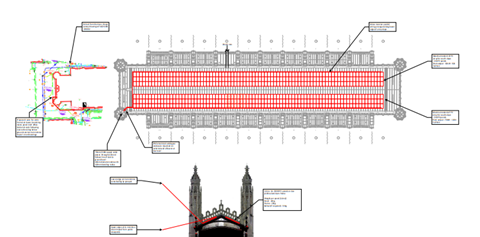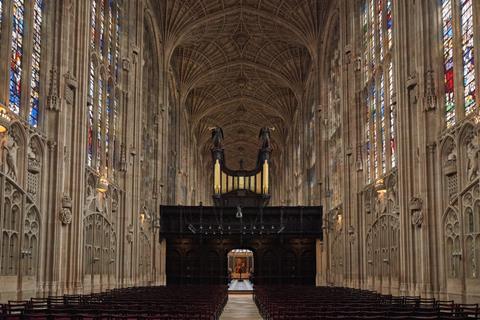Cambridge council unanimously approves controversial plans despite recommendations for refusal from both Historic England and its own planning officer

The roof of King’s College Chapel in Cambridge is set to be almost entirely covered in solar panels under plans approved this week.
The council’s planning committee unanimously approved the proposals despite a recommendation for refusal by the planning officer and strong objections from Historic England.
Nearly 500 photovoltaic panels will be installed on the grade I-listed building, which was built between 1446 and 1515 and is considered to be among the finest gothic structures in Europe.
The move is part of the college’s target to decarbonise its operations by 2038, with the panels expected to supply 100% of the chapel’s energy needs and reduce the Cambridge University college’s carbon emissions by more than 27 tonnes each year.
The plans have been drawn up by heritage practice Caroe Architecture, which has worked on a number of high profile schemes at grade I-listed buildings including the installation of a new staircase and internal portico at St Paul’s Cathedral in London.
Historic England had recommended the application be refused, writing in a letter to the council that the panels would “harm the significance of what is an exceptionally significant building”.
“Wherever they would be visible, the solar panels would be discordant: their appearance would shift with the weather, and be alien to that of the Chapel’s historic materials,” the group said.

“They would damage the architectural character and interest of the building, by overlaying much of the renewed lead roof covering with an additional covering of radically different character. Indirectly, they would also harm the Chapel’s historic interest.”
In a response to the objection, the scheme’s planning consultant Turley said the chapel roof was the “single largest potential opportunity for renewable electricity generation on the main college site”.
It added that a currently ongoing refurbishment of the building’s lead roof provided a “once in a lifetime opportunity to do this work now”.
“The lost opportunity cost of not doing this now equates to the emission of approximately 410 tonnes CO21 between now and 2050 and is independent of any electrification of heating demands,” Turley said.

While Cambridge’s planning officer agreed the generation of renewable energy had a clear public benefit, it said in its recommendation for refusal that the visibility of the panels would harm the significance and historic interest of the chapel.
“The proposal would apply a roof covering of a radically different character and appearance than the traditional lead roof,” the officer’s report said.
“The application of the PV panels would visually detract from the architectural character of the roof and skyline and be discordant with the architectural composition of this exceptional and historically iconic medieval building.
“Important views of the chapel would be harmed, damaging the appreciation of the chapel’s architectural interest, and eroding its authenticity and integrity.”
King’s College Chapel is considered to be a defining example of perpendicular gothic architecture, a late medieval style which was unique to England. It is characterised by large windows, straight lines and fan vaults, with the largest example of the latter found at King’s College Chapel.
What King’s College said:
King’s College provost Michael Proctor said: “We are greatly heartened by the Council’s unanimous decision to approve the proposal to install photovoltaic panels on the roof of the Chapel, and the demonstrable commitment to taking action on climate change that the decision signifies.
”As the Planning Committee noted, the panels will have only a very minimal impact on the visual appearance of the Chapel, but will make a considerable, quantifiable difference in the process of decarbonisation.
”Having been careful stewards for nearly 600 years, as a College we are inherently aware of the duty we have to protect the Chapel as a building of exceptional significance, for the benefit of everyone, forever.”
















2 Readers' comments